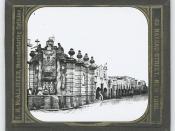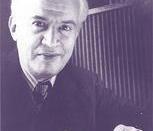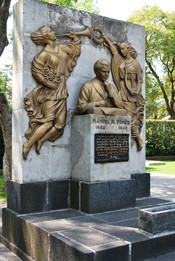Unit 10The Guitar in MexicoObjectivesAt the end of this unit, the student should be able to:A. Comprehend the history of the guitar and guitar composers/players in Mexico.
B. Identify the major guitar composers in Mexico.
C. Be familiar with the names of some of the more famous pieces of guitar music from Mexico.
Key Termsbasso continuo-- the technique of improvising harmony to a written bass line.
Haydn--Franz Josef Haydn (1732-1809), a very famous Classical composer from Austria.
Impressionism--a style of music characterized by a rejection of traditional Western-based harmony and tonality. It also can have dissonance and irregular rhythms.
counterpoint--a technique of opposing voices moving in contrary motion.
passacaglia--an Italian or Spanish dance form with a repeated theme.
This Gigue by Manuel Ponce is performed by Horst Klee.
The first guitar probably was brought to Mexico by a monk in the 1700's and it has since become the "national instrument."
Although the modern guitar with six single strings is the predominant form of the instrument in use, there are several other versions of strummed and plucked fretted stringed instruments in Mexico that are of the guitar family. Among them are jaranas, requintos, leonas, boconas, vihuelas and bajos sextos. They range in size from very small instruments made of armadillo shells to the very large guitarrón.
The earliest guitars played in Mexico were baroque guitars. They typically had five courses (pairs of strings) and were much smaller that their contemporary cousins. They were most often used to accompany singers and melodic instrumentalists. However, there is evidence that one of the most important Spanish guitarists of the baroque era (1600-1750), Santiago de Murcia (born, Madrid, c.1682) settled in Mexico and lived there until his death c.1740. In the early 1700s, Murcia was appointed guitar teacher to Queen MarÃÂa Luisa Gabriela, the young wife of Felipe V, King of Spain.
Santiago de Murcia arrived in Mexico as early as 1719 or as late as 1730. No one knows the exact dates of his arrival or of his death. What is known is that some of his most important work dates from his time in Mexico. The manuscripts for "SaldÃÂvar Codex no.4" and the "Passacalles y obras de guitarra por todos los tonos naturales y acidentales" (Passacaglias and Works for Guitar for all the Natural and Accidental Tones) date from 1732. His "Resumen" of the same period is considered by many the most extensive treatise on basso continuo, the technique of improvising harmony to a written bass line. He also produced many arrangements for solo guitar including some of the first written examples of early Spanish dances such as the jácara, mariona, gallarda, villano and españoleta. He also produced the earliest manuscripts of fandangos, jotas and seguidillas, among the most important dances in Spanish culture. Carrying on the European and Asian traditions of melding cultural styles, Murcia was the first to publish African-American cumbés and zarambeques. Today, we would call his approach world music.
Luis de Medina(b 1751; d 1806). "Mexican guitarist and composer. He was a native of Puebla, Mexico and, at the age of 19, moved to Mexico City. There he performed in comedias and other theatrical productions, as did his two daughters who were singers. His most notable work is Siana y Silvio, which received its première in Mexico City's main theatre, the Coliseo, in 1805. He excelled in other areas as well, and served as an accountant in the Royal Court of Justice." (Russell and Stevenson, 173-4)François de Fossa was born on August 31, 1775, in the city of Perpignan in southern France near the Spanish border. At the beginning of the French Revolution, de Fossa went to Spain to join other French officers, Gentlemen of the Nobility, known as the "Legion of the Pyrénées." At the age of 21 in 1796, he was summoned to serve directly under the Spanish War Minister, Miguel d'Azanza. In 1789, Carlos IV appointed d'Azanza as Viceroy of Mexico and d'Azanza took de Fossa with him. He returned to Spain in 1803 and had a successful military career until he retired in 1844. He died in Paris in 1849.
Although very little is know about de Fossa's musical activities in Mexico, he very likely would have played in casual social settings and would have sought out others for musical fellowship while there. At the time, there were many upper middle class and noble immigrants who enjoyed a vigorous cultural scene. In addition to his military career, he was well thought of in musical circles upon his return to Europe and was called the "Haydn of the Guitar." He was an accomplished composer and teacher and is credited by Dionisio Aguado with inventing artificial harmonics, a technique in which the guitarist plucks a string while touching it at one of the node points to make a bell like sound. Probably his greatest contribution to the music world is that his copies of the Boccherini Quintets for Guitar and String Quartet are the only copies that survived the era.
Manuel MarÃÂa Ponce Cuéllar (1882-1948) was born in Zacatecas, Mexico and received his early training and professional experience in Mexico. He was primarily known as a composer, but was also a virtuoso pianist and an accomplished conductor. He studied in Paris in the 1920s with the French composer Paul Dukas where he added Impressionism to his tonal palette. His earlier works were composed in a genteel salon style that he abandoned for the more formalized and structured European music of the day. His employment of counterpoint (a technique of opposing voices moving in contrary motion) was fused with Impressionism along with his nationalistic style of using Mexican folk music as a starting point for melodic and rhythmic ideas.
The great 20th century Spanish guitarist Andres Segovia inspired Manuel Ponce to write some of his best music. The partnership between Ponce and Segovia produced much of the early foundational works of the modern guitar repertoire including one of the most widely performed concertos of the modern era. His many compositions include music for piano, violin, orchestra and chamber music as well many songs. His wrote his most famous song, "Estrellita", in 1914 and received only the equivalent of $5 for it from his publisher. Carlos Chavez and Silvestre Revueltas have eclipsed Ponce's place in Mexican music history, but many are coming to know Ponce's better works and, for now, the jury's out.
Carlos Chávez, 1899-1978 wrote only a few works for guitar. His solo guitar output is limited to "Three Pieces for Guitar - Largo, Tranquillo and Un poco mosso" as well as his "Feuille d'Album." They are very rarely performed in public.
Rafael Adame (c.1906 - 1963) wrote and performed the first twentieth-century guitar concerto. He was born in Autlán de la Grana, Jalisco, Mexico.
Jesús Silva (1914-1996), a student of Francisco Salinas was an influential and beloved teacher primarily in Mexico and the U.S. He studied composition with Manuel Ponce and guitar with Andres Segovia and held positions at several prestigious institutions including the National Conservatory of Music in Mexico and the North Carolina School of Music. Of particular note to DCCCD students, he taught several masterclasses in Dallas at the invitation of one of his prominent students, Robert Guthrie, now head of the guitar program at Southern Methodist University.
Composer, Samuel Zyman of Mexico City, Mexico, has won many coveted prizes and is on the distinguished faculty of the Julliard School in New York. In addition to his numerous works for guitar, he also composes symphonies, film scores, songs and chamber music.
Many of Mexico's best composers throughout history have avoided the guitar because, as in the rest of the world, it was considered a crude folk instrument not worthy of serious consideration. Fortunately, the classical guitar is accepted in most colleges, universities and conservatories, thanks in good part to the artistic evangelizing of Segovia in the 20th century.
Many of the leading guitarists who have made careers based in Mexico are not native Mexicans. Most notably is Argentine, Manuel Lopez Ramos. There are many virtuoso Mexican guitarists living abroad.
One of several exceptions:Award winning classical guitarist Juan Carlos Laguna is considered one of the most outstanding guitarists of his generation. International critics applaud his technique and expressive musicianship. Born in Mexico City, Laguna studied at the National University Music School where he graduated with honors and is now a faculty member. In 1991, Laguna was awarded First Prize at Tokyo's International Guitar Competition, having competed with over 86 other guitarists from all over the world. He has performed with all leading orchestras of Mexico, as well as in Argentina, Costa Rica, Cuba, France, Germany, Guatemala, Italy, Japan, Peru, Puerto Rico and the U.S. Recently, as soloist with the London Symphony Orchestra, Mr. Laguna recorded the Guitar Concerto by Lalo Shifrin.
German Vasquez Rubio and Abel Garcia are among the more prominent guitar builders from Mexico. For more information on guitar builders in Mexico search on Paracho, Mexico.
Works CitedLaguna, Juan Carlos. Program Notes. No date.
Ophée, Matanya. Guitar And Lute Issues:The On-line Magazine of Editions Orphée. http://www.orphee.com .
Russell, Craig, ed. Stevenson R., "Music in Mexico: a Historical Survey," New York, 1952.
Groves Music Online. London: Oxford University Press, 2005.
http://0-www.grovemusic.com.library.dcccd.edu/grove-owned/music/about.html.
Source material for this entry that is not cited is from un-credited program notes and from memory and sources already cited.
Suggested ReadingOphée, Matanya. Adame. http://www.orphee.com/madreng.htm .
Ophée, Matanya. De Fossa. http://www.orphee.com/defossa/mexico.htm .
Ophée, Matanya. Guitar And Lute Issues:The On-line Magazine of Editions Orphée. http://www.orphee.com .
Web LinksOphée, Matanya. Adame. http://www.orphee.com/madreng.htm .
Ophée, Matanya. De Fossa. http://www.orphee.com/defossa/mexico.htm .
Ophée, Matanya. Guitar And Lute Issues:The On-line Magazine of Editions Orphée. http://www.orphee.com .
![Mexico - troops in Calle de Revilladigego [i.e. Revillagigedo] (LOC)](https://s.writework.com/uploads/5/56104/mexico-troops-calle-revilladigego-e-revillagigedo-loc-thumb.jpg)




